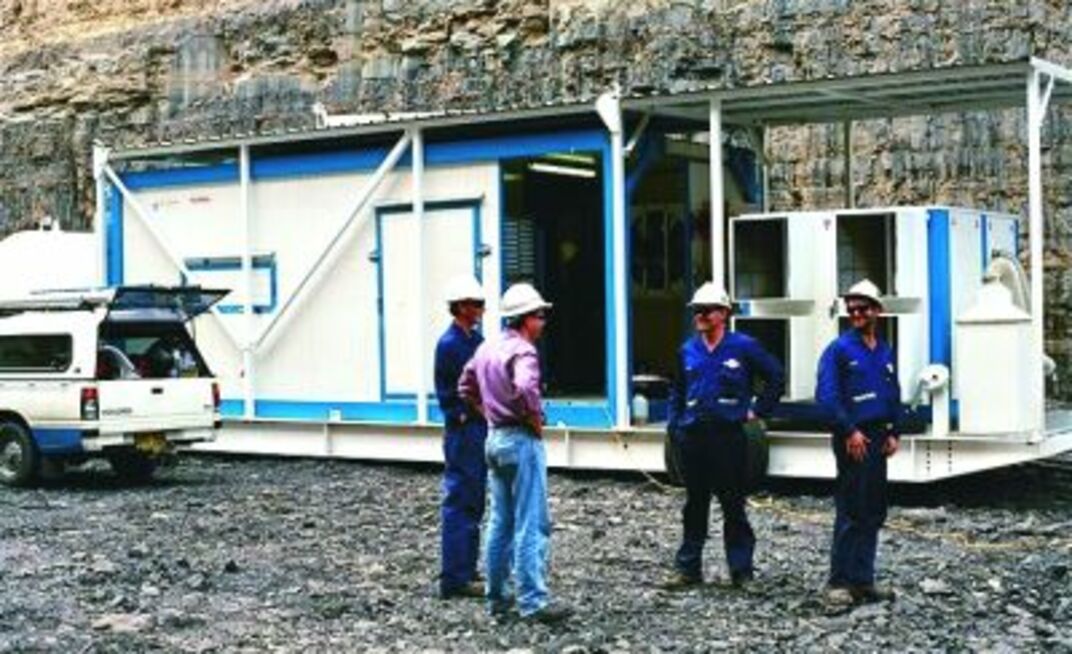Published in March 2005 Australian Longwall Magazine
In January 2005, when gas readings from a sealed roadway at the Kestrel mine in Queensland went into the explosive range, the mine decided to inertise the roadway as a precaution.
The industry standard solution was Tomlinson Boiler technology using boiler exhaust as inert gas, but it was not available at the time. The Rio Tinto-owned Kestrel mine turned to the Floxal nitrogen system that has been used sporadically in underground mines since 2000.
Supplied by Air Liquide, the Floxal technology was first introduced to Australia for highwall mining in 1998.
Air Liquide developed a mobile inerting solution for Mining Technologies Australia (now Roche Mining) comprised of two portable 500 cubic metres per hour systems. These were used to inertise highwall driveage at 97% nitrogen. The first underground application took place at the Oaky Creek mine in 2000 when the Floxal unit was used for goaf inertisation.
Since then the Floxal unit has been used successfully at mines including Dartbrook, German Creek, Oaky North and Oaky No.1 mines.
The method involves bringing a mobile unit on site and pumping nitrogen gas into a mine through surface boreholes.
Studies conducted by the CSIRO in 2002 identified no differences in the effectiveness of boiler gas and nitrogen gas for goaf inertisation in site tests at the Newlands mine. However, that was about the only thing the two approaches had in common.
The Floxal technology passes common-variety compressed air through hollow membrane fibres. Differences in the polarity of nitrogen and oxygen molecules allow the oxygen and water to be separated out and rejected. Nitrogen at a purity of up to 99.5% can be produced, though in coal mine applications the purity is set at 97%, based on the experience of coal mines and expert advice.
Until recently Air Liquide had not actively pursued coal mining as a growth opportunity but continued interest from customers provided the impetus for a series of investigations, said Air Liquide national product manager Sajimon Joseph.
“Feedback from customers tells us they want a bigger unit than is currently available,” Joseph said.
The Tomlinson boilers are nominally rated at 1800cu.mph, but the current Roche hire Floxal equipment is only capable of 500cu.mph, due to it being designed for use in highwall applications.
Air Liquide said a 1934cu.mph unit would be more than adequate for goaf inertising, and expected to be supplying several Floxal units at this capacity this year.
A firm order for the first such unit is currently being negotiated. Air Liquide’s business model is such that it won’t commit to manufacturing units unless customers commit to long-term lease deals. In the past, these have been in the order of ten years, but Joseph said the company was prepared to negotiate more flexible timeframes.
Unlike the boiler, which uses water and up to 6000 litres of diesel fuel per day, the Air Liquide system runs on electricity. A unit producing 1934cu.mph of inert gas requires 805kW of electricity or a specific energy consumption of 0.42 units per cubic metre of inert gas.
This means it does not produce carbon monoxide and is extremely environmentally friendly. Its waste product is oxygen.
“The method used in flue-gas generation means there is always the chance of carbon monoxide being present in the gas. This is potentially hazardous to employees working underground,” Joseph said.
“A second problem is that the presence of carbon monoxide can mask the heating profile in the goaf, which has happened before.”
Another big advantage with the Floxal unit is nitrogen is expelled at around 9bar. (The boiler produces only around 1bar.)This means, significantly, that the nitrogen can be reticulated vast distances around a minesite – not possible with the boiler.
Using a 6-inch pipe, the nitrogen can travel up to 92km; gas in a 4in poly-pipe can travel 12.5km.
This means several things. Firstly, the Floxal unit can be situated close to power and the nitrogen sent anywhere in the mine.
Secondly, it offers mines the option of managing inertisation proactively. Joseph envisages a semi-permanent Floxal installation at a mine, producing nitrogen on demand to keep goafs inert. As a longwall progresses, additional structure could simply be added.
He said other advantages were the Floxal system runs remotely and does not require an operator in attendance. Continuous monitoring of the product stream takes place through a flow meter and is used to monitor performance and for preventive maintenance.
Joseph emphasised the gas company does not sell equipment – it sells molecules. Air Liquide is responsible for maintenance and guarantees a system availability of 98%. The units are incredibly robust and are in service around the world in industrial applications that require around-the-clock nitrogen supply.
























